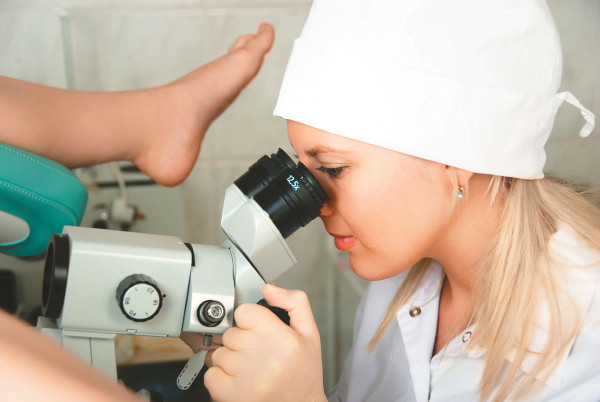Cervical cyst: causes, symptoms, treatment
In many women of reproductive age, cysts form on the cervix. This disease is observed in 15% of women. Usually a woman finds out about the disease after a visit to the gynecologist, when the time has already been lost.
Causes of the cervical cyst
This neoplasm is a blockage of the glands in the cervix or their expansion. The glands that produce mucus become clogged as a result of the inflammatory process. From this, mucus accumulates inside the gland, and it becomes larger. These changes are visible with colposcopy or as a result of ultrasound.

It is not possible to identify with precision any specific cause of the formation of a cyst, but the following possible factors that affect the formation of a cyst are distinguished:
- Damage to the cervix during childbirth. After the birth of the baby, the cervix begins to quickly recover. Sometimes because of this, the activity of the glands is disrupted and cysts are formed.
- Incorrect or unprofessional abortion can also serve as a factor provoking the formation of a cyst.
- During menopause, changes occur in the structure of the internal genital organs of a woman. The thinning membrane makes the glands vulnerable. As a result, any irritation makes the glands work more actively. Mucus accumulates inside the gland and a cyst forms.
- Diseases of an infectious nature can also cause blockage of the ducts of the gland.
These factors most often provoke the formation of a cyst. But there are other possible causes that are less likely to lead to pathology. These include intrauterine devices, metabolic disorders in the body and inflammation of the appendages.
Symptoms of a cervical cyst
As we have already noted above, women find out about the disease very late, after the next visit to the women's doctor. The reason for such a late diagnosis is that at first the disease proceeds absolutely without any symptoms. In this case, timely detection of the disease is possible only after diagnosis or comprehensive examination.
 With a large cyst of the cervix, a woman feels the following signs of the disease:
With a large cyst of the cervix, a woman feels the following signs of the disease:
- Bloody discharge from the cervix appears.
- Periodically felt in the lower abdomen pain.
- Sexual intercourse is usually painful.
- An unpleasant odor is felt from the vagina, directly indicating the presence of inflammation.
Neoplasms on the cervix are usually detected by a doctor during a visual examination, as a result of ultrasound diagnostics, or when viewed with a colposcope. The examination involves taking smears for the presence of an infection of a urogenital nature, as well as studying the hormonal state of a woman, in some cases a biopsy is performed.
Treatment of cervical cysts
After a comprehensive examination, a decision is made on the appointment of the necessary treatment. It should be noted that before starting treatment for a cyst, it is necessary to completely cure all urogenital infections, if any.
Medicinal methods of treating cysts are never used, since they do not bring results even in the initial phase of the development of the disease. Usually, the cyst is cut and removed by surgery. This operation is simple and is performed under the influence of local anesthesia. This simple operation is done on an outpatient basis. Do not delay the operation, as, growing, the cyst will bring a feeling of discomfort and pain.
 Another practiced method of treating a cyst is to pierce its shaft and press the contents in. After removing the secret, the wound is disinfected with a special solution. The final phase of treatment includes the use of medication and physical therapy. This takes into account the physical condition, age of the woman and the characteristics of her internal organs. Recovery usually takes a short period of time.
Another practiced method of treating a cyst is to pierce its shaft and press the contents in. After removing the secret, the wound is disinfected with a special solution. The final phase of treatment includes the use of medication and physical therapy. This takes into account the physical condition, age of the woman and the characteristics of her internal organs. Recovery usually takes a short period of time.
Now, a laser is often used to treat cysts. Such treatment of the affected area allows you to relieve inflammatory processes in the tissues and immediately complete vascular coagulation is performed. In this way, heavy bleeding is avoided. The disadvantage of this procedure is that it is very painful.
Another modern way to eliminate cysts on the cervix is to treat the affected surface with liquefied nitrogen. This technique allows you to remove the cyst painlessly. Another plus of the procedure is the absence scar tissue after healing.
Since the cyst is treated on an outpatient basis, the woman can go home immediately after the procedure. In the following days, the woman feels slight painful sensations in the lower abdomen, she is tormented by weakness and high fatigue. After surgery, the use of vaginal suppositories with a healing effect is usually recommended.
Another common method of removing neoplasms on the cervix is to cauterize them with chemicals or high temperatures. Radio wave therapy is used to treat cysts in young women who have not yet given birth. The cyst is exposed to a special apparatus that emits high-frequency radio waves.
Two days after the intervention, vaginal discharge becomes yellowish and lasts about a week. A month after the treatment, a control examination is carried out in order to assess the result of the operation.


